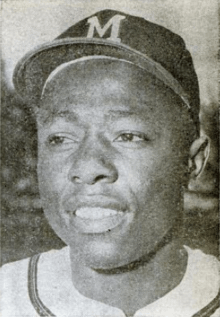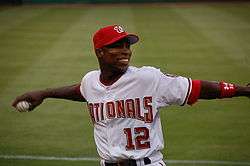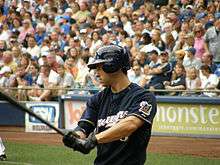30–30 club

In Major League Baseball (MLB), the 30–30 club is the group of batters who have collected 30 home runs and 30 stolen bases in a single season.[1][2] Ken Williams was the first to achieve this, doing so in 1922.[3][4] He remained the sole member of the club for 34 years until Willie Mays achieved consecutive 30–30 seasons in 1956 and 1957.[4][5] Bobby Bonds became the club's third member in 1969 and became the first player in MLB history to reach the 30–30 club on five occasions,[5][6] subsequently achieving the milestone in 1973, 1975, 1977 and 1978.[4] He remained the only player to accomplish this until 1997, when his son Barry Bonds achieved his fifth 30–30 season.[4]
In total, 38 players have reached the 30–30 club in MLB history and 13 have done so more than once. Of these 38 players, 26 were right-handed batters, 8 were left-handed and 4 were switch hitters, meaning they could bat from either side of the plate. Ten of these players (including eight active members of the 30–30 club) have played for only one major league team. The Cincinnati Reds, Colorado Rockies and New York Mets are the only franchises to have three different players reach the milestone while on their roster. Five players—Hank Aaron, Barry Bonds, Willie Mays, Alex Rodriguez and Sammy Sosa—are also members of the 500 home run club,[7] and Aaron, Mays and Rodriguez are also members of the 3,000 hit club.[8] Dale Murphy, Jose Canseco, Barry Bonds, Larry Walker, Jimmy Rollins and Braun won the Most Valuable Player (MVP) Award in the same year as their 30–30 season, with Bonds achieving this on two occasions (1990 and 1992).[9] Both Mays and Rollins also reached the 20–20–20 club in the same season, that being Mays second 30-30 season, and in Rollins only 30-30 season.[10][11][12] Four different players accomplished 30–30 seasons in 1987, 1996, 1997 and 2011, the most in a single season.[4]
Due to the rarity of a player excelling in the combination of hitting home runs and stealing bases,[5] Baseball Digest called the 30–30 club "the most celebrated feat that can be achieved by a player who has both power and speed."[2] Of the 22 members eligible for the Baseball Hall of Fame, three have been elected and two were elected on the first ballot. Eligibility requires that a player has "been retired five seasons" or deceased for at least six months,[13] disqualifying fourteen active players and two players who have been retired for less than five seasons.
Members





| Year | The year the player's 30–30 season occurred |
|---|---|
| Player (X) | Name of the player and number of 30–30 seasons they had accomplished at that point |
| Italics | Player achieved the 40–40 club that year |
| Team | The player's team for his 30–30 season |
| HR | Number of home runs in that year |
| SB | Number of stolen bases in that year |
| ^ | Denotes 40–40 season |
| Elected to the Baseball Hall of Fame | |
| Player is active |
See also
- 20–20–20 club, similar multiple stat club for doubles, triples and home runs.
- Baseball statistics
- Triple Crown
References
General
- "30–30 Club". Baseball-Almanac.com. Baseball Almanac. Retrieved July 4, 2012.
- "The 30–30 Club – Rare Feats". MLB.com. Major League Baseball. Retrieved July 4, 2012.
Specific
- ↑ Dorfman, John (April 17, 2011). "His 30–30 club has 5 stocks as stars". Omaha.com (Bloomberg News). Retrieved June 24, 2012.
In baseball, the club is for ballplayers who belt 30 home runs and steal 30 bases in the same season.
- 1 2 3 Deane, Bill (May 1987). "Here Are Top Candidates To Join Elite '30–30' Club". Baseball Digest. Evanston, Illinois: Century Publishing. 46 (5): 34. ISSN 0005-609X. Retrieved July 8, 2012.
- ↑ Vass, George (July 2004). "Baseball's Forgotten Stars". Baseball Digest. Evanston, Illinois: Century Publishing. 63 (7): 31. ISSN 0005-609X. Retrieved July 9, 2012.
- 1 2 3 4 5 Newman, Mark (August 30, 2011). "Versatile crop of players could join 30–30 club". MLB.com. Retrieved June 25, 2012.
- 1 2 3 4 Stewart, Wayne (May 1990). "Blend of Power and Speed: A Major League Rarity". Baseball Digest. Evanston, Illinois: Century Publishing. 49 (5): 34–35. ISSN 0005-609X. Retrieved July 8, 2012.
- ↑ Dorfman, John (April 12, 2010). "Three Stocks Take Top Honors In Elite 30–30 Club". Bloomberg. Retrieved June 25, 2012.
Bobby Bonds and his son Barry Bonds each did it five times.
- ↑ "Career Leaders & Records for Home Runs". Baseball-Reference.com. Retrieved July 4, 2012.
- ↑ "Career Leaders & Records for Hits". Baseball-Reference.com. Retrieved July 4, 2012.
- ↑ "Most Valuable Player MVP Awards & Cy Young Awards Winners". Baseball-Reference.com. Retrieved May 24, 2012.
- ↑ "Rollins gets 20th triple and joins rare 20–20–20–20 club". ESPN. ESPN Internet Ventures. Associated Press. September 30, 2007. Retrieved July 21, 2012.
- ↑ Tsao, Bryan; Bolado, Carolina; Distelheim, Joe (November 30, 2007). The Hardball Times Baseball Annual 2008. ACTA Publications. p. 26. ISBN 9780879463410. Retrieved July 8, 2012.
Wasn't Jimmy Rollins...the key to this offense? Thirty home runs, more than 200 hits, the fourth 20–20–20–20 (doubles, triples, home runs and stolen bases) player in the history of the game.
- 1 2 3 "Willie Mays Statistics and History". Baseball-Reference.com. Retrieved May 8, 2012.
- ↑ "Rules for Election". National Baseball Hall of Fame. Retrieved July 4, 2012.
- ↑ "Ken Williams Statistics and History". Baseball-Reference.com. Retrieved June 25, 2012.
- ↑ "Hank Aaron Statistics and History". Baseball-Reference.com. Retrieved June 25, 2012.
- 1 2 3 4 5 "Bobby Bonds Statistics and History". Baseball-Reference.com. Retrieved June 25, 2012.
- ↑ "Tommy Harper Statistics and History". Baseball-Reference.com. Retrieved June 25, 2012.
- ↑ "Dale Murphy Statistics and History". Baseball-Reference.com. Retrieved June 25, 2012.
- ↑ "Joe Carter Statistics and History". Baseball-Reference.com. Retrieved June 25, 2012.
- ↑ "Eric Davis Statistics and History". Baseball-Reference.com. Retrieved June 25, 2012.
- 1 2 3 "Howard Johnson Statistics and History". Baseball-Reference.com. Retrieved June 25, 2012.
- ↑ "Darryl Strawberry Statistics and History". Baseball-Reference.com. Retrieved June 25, 2012.
- ↑ "Jose Canseco Statistics and History". Baseball-Reference.com. Retrieved May 10, 2012.
- 1 2 3 4 5 "Barry Bonds Statistics and History". Baseball-Reference.com. Retrieved May 10, 2012.
- 1 2 "Ron Gant Statistics and History". Baseball-Reference.com. Retrieved June 25, 2012.
- 1 2 "Sammy Sosa Statistics and History". Baseball-Reference.com. Retrieved June 25, 2012.
- ↑ "Dante Bichette Statistics and History". Baseball-Reference.com. Retrieved June 25, 2012.
- ↑ "Ellis Burks Statistics and History". Baseball-Reference.com. Retrieved June 25, 2012.
- ↑ "Barry Larkin Statistics and History". Baseball-Reference.com. Retrieved June 25, 2012.
- 1 2 "Jeff Bagwell Statistics and History". Baseball-Reference.com. Retrieved June 25, 2012.
- 1 2 "Raúl Mondesí Statistics and History". Baseball-Reference.com. Retrieved June 25, 2012.
- ↑ "Larry Walker Statistics and History". Baseball-Reference.com. Retrieved June 25, 2012.
- ↑ "Shawn Green Statistics and History". Baseball-Reference.com. Retrieved June 25, 2012.
- ↑ "Alex Rodriguez Statistics and History". Baseball-Reference.com. Retrieved May 10, 2012.
- ↑ "Preston Wilson Statistics and History". Baseball-Reference.com. Retrieved June 25, 2012.
- 1 2 "Bobby Abreu Statistics and History". Baseball-Reference.com. Retrieved June 25, 2012.
- ↑ "José Cruz Statistics and History". Baseball-Reference.com. Retrieved June 25, 2012.
- 1 2 "Vladimir Guerrero Statistics and History". Baseball-Reference.com. Retrieved June 25, 2012.
- 1 2 3 4 "Alfonso Soriano Statistics and History". Baseball-Reference.com. Retrieved May 10, 2012.
- ↑ "Carlos Beltrán Statistics and History". Baseball-Reference.com. Retrieved June 25, 2012.
- ↑ "David Wright Statistics and History". Baseball-Reference.com. Retrieved June 25, 2012.
- ↑ "Jimmy Rollins Statistics and History". Baseball-Reference.com. Retrieved May 8, 2012.
- ↑ "Brandon Phillips Statistics and History". Baseball-Reference.com. Retrieved June 25, 2012.
- ↑ "Grady Sizemore Statistics and History". Baseball-Reference.com. Retrieved June 25, 2012.
- ↑ "Hanley Ramírez Statistics and History". Baseball-Reference.com. Retrieved June 25, 2012.
- 1 2 "Ian Kinsler Statistics and History". Baseball-Reference.com. Retrieved June 25, 2012.
- ↑ "Matt Kemp Statistics and History". Baseball-Reference.com. Retrieved June 25, 2012.
- 1 2 "Ryan Braun Statistics and History". Baseball-Reference.com. Retrieved June 25, 2012.
- ↑ "Jacoby Ellsbury Statistics and History". Baseball-Reference.com. Retrieved June 25, 2012.
- ↑ "Mike Trout Statistics and History". Baseball-Reference.com. Retrieved September 30, 2012.